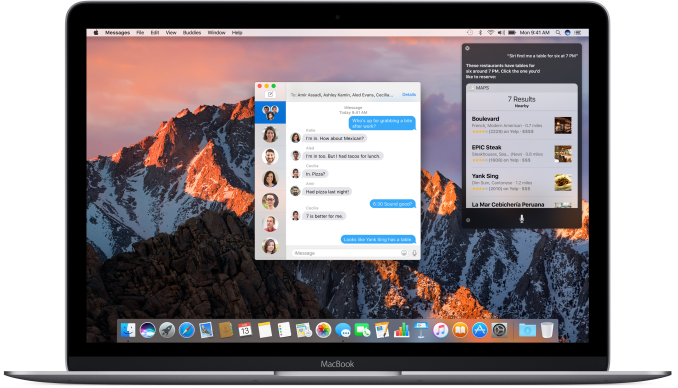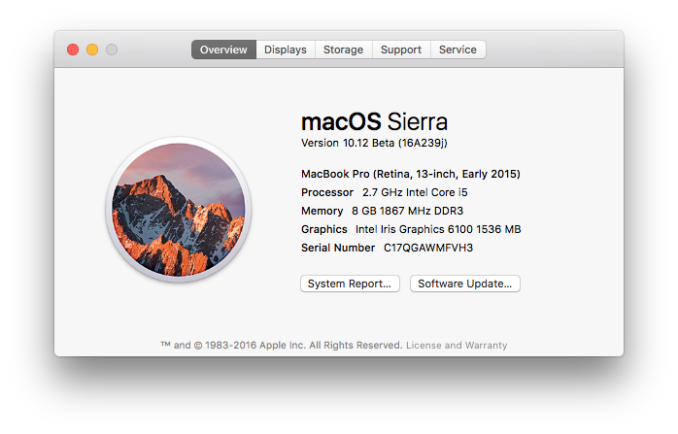A First Look At Apple's macOS Sierra
by Brandon Chester on July 13, 2016 8:00 AM EST- Posted in
- Mac
- Apple
- Operating Systems
- macOS

As with past years, Apple's WWDC 2016 keynote showcased the upcoming updates to Apple's operating systems and developer tools. It's hard to believe that iOS is now on its tenth major version, which put Apple in an interesting position since their desktop operating system has been called OS X for many years now. Given that Apple's other operating systems are named iOS, watchOS, and tvOS, the name OS X has become a bit of an outlier. This year's release comes with a new name in the typical manner that OS X releases each had a specific name, but also a new name for the operating system itself. The 2016 version of Apple's operating system for Macs is named macOS Sierra.
While macOS adopts a new name, it retains the existing versioning system, with macOS Sierra being version 10.12. This makes sense when you consider the progression from Mac OS 9 to Mac OS X, which then treated each release as a point update on top of ten and only dropped the Mac in the name in 2012. This kind of versioning is somewhat awkward, and will be more so when it gets to the point where the OS is version 10.20. It will be interesting to see if the next truly large update to macOS brings it to major version eleven, and it could be that Apple plans to keep it in sync with iOS with a new major version number each year, but only time will tell.
Like all updates to macOS, Sierra comes with a number of new features. With the bulk of Apple's device sales being mobile devices, there have been a number of features in recent versions of macOS that work to leverage how devices running macOS, iOS, and watchOS can work together. Having cloud sync across devices is one thing, but building and properly executing Apple's continuity features really requires control over the hardware and software stacks across all devices. Unfortunately it's difficult to test these features during Apple's beta period, but that just gives Apple's users things to look forward to later in the year.
More important than new features is whether or not a Mac can even be upgraded to macOS Sierra from OS X El Capitan. Apple has announced the compatibility list for Sierra, and there are some older Macs that have dropped off the list. I've put together a chart comparing the compatibility of Macs with El Captain and compatibility with Sierra.
| OS X El Capitan | macOS Sierra | |
| MacBook Pro | Mid 2007 and newer | 2010 and newer |
| MacBook Air | Late 2008 and newer | 2010 and newer |
| Old MacBook | Late 2008 aluminum and newer | Late 2009 and newer |
| New MacBook | 2015 and newer | |
| iMac | Mid 2007 and newer | Late 2009 and newer |
| Mac Mini | Early 2009 and newer | 2010 and newer |
| Mac Pro | Early 2008 and newer | 2010 and newer |
As you can see, it looks like Apple has put the cutoff point right around the start of this decade. The old MacBook and iMac that released in late 2009 make the cut, but everything else has to be a model from 2010. The uniformity of the cutoff makes it fairly likely that this was a somewhat arbitary decision, although it's difficult to say exactly how many older Macs could have been put on the list because Apple offers many SKUs and CTO options that could make one version of an older Mac fast enough and another from the same line too slow. In any case, the easy rule with Sierra is that if your Mac is from before 2010 it's probably not supported, and if you're in that group you're probably overdue for an upgrade anyway.
With Apple having just released their public beta of macOS Sierra, it's worth going over the major features that are currently available for users to try before the OS is officially launched later this year. Features like Auto Unlock and Apple Pay on the web can't really be shown right now, but it is possible to show other features that work between iOS and macOS devices like the additions to Messages and Photos. While I think the smaller and more subtle features in software updates can be some of the most useful, It's probably best to start off with the biggest feature in Sierra, which is Siri coming to the Mac.











81 Comments
View All Comments
snowmyr - Wednesday, July 13, 2016 - link
The first four siri photos are excellent for people who read right to left.DPUser - Wednesday, July 13, 2016 - link
Just an FYI, workarounds have already been developed in the Mac community enabling Sierra (beta) to be installed on easier Mac Pros. The simplest is available to owners of 4,1 (2009) Mac Pros; Update EFI to 5,1 (2010) firmware and your 2009 Mac, for all intents and purposes, is now a 2010. The update also allows CPU swaps up to the fastest hex cores available for the era, W3690 and X5690.DPUser - Wednesday, July 13, 2016 - link
That would be "earlier" Mac Pros.marty1980 - Wednesday, July 13, 2016 - link
I'd really like to see Apple break iTunes out into separate apps on macOS and Windows. Like on iOS, have Videos, Music, App Store, and iTunes Store. Each could be improved on its own schedule instead of all of it having to be updated at once the way it is.Continuity and iMessage are actually a problem in our house because we share iPads. This means private messages get sent to iPads when we don't want and it's a pain to deal with the way we use our devices. I know there will be suggestions but we have probably already heard them all. Maybe we're outliers.... We just can't use iMessage.
Impulses - Wednesday, July 13, 2016 - link
You can't have separate user profiles on iOS? Huh...B3an - Wednesday, July 13, 2016 - link
So typical of this dying site. Apple OS shit but no Win 10 update/anniversary article, even though it's basically complete now and builds have been available for far longer.Impulses - Wednesday, July 13, 2016 - link
Ryan commented it's coming, tho they could probably have written/published it already since (as you say) it's at least as far along as Sierra.ex2bot - Friday, July 15, 2016 - link
Man, it is so dying for sure. Anand would NEVER allowed this Apple stuff. Who uses Apples?? Amirite?/s
DonMiguel85 - Wednesday, July 13, 2016 - link
Funny the 2009 MacBook Airs didn't make the cut since they still have the GeForce 320M and Core 2 Duo like the 2010 model.tipoo - Monday, July 18, 2016 - link
Yeah, makes no sense because the Macbook sans-moniker with a Core 2 Duo and 320M does get it. Some of the cutoffs are really strange in this one.